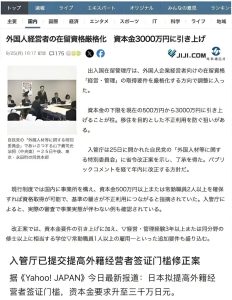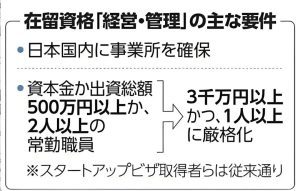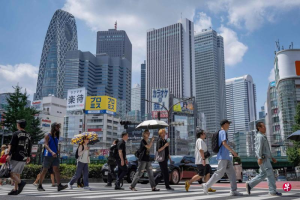In today’s globalized landscape, “securing a visa to secure a future” has become a key consideration for many entrepreneurs and investors. But this summer, Japan delivered a heavy blow:
The capital requirement for the Business Management visa has skyrocketed from 5 million yen to 30 million yen, with a mandate to hire at least one full-time employee. The new policy will take effect as early as mid-October.
This move sent shockwaves through the community. For foreigners who had long viewed Japan as a springboard for entrepreneurship, this represents not only a fivefold increase in financial pressure but also a collective reckoning with identity, dreams, and reality. Who is most anxious? The answer may already be written between the lines of the policy.

I. Trading a Visa for a Future: Japan’s Sudden Policy Tightening
1. Business Manager Visa Investment Requirement Raised to ¥30 Million
According to a Reuters report from Tokyo, Japan’s Ministry of Justice released a draft document on August 26:
Plans to tighten requirements for the “Business Manager Visa,” raising the capital requirement from ¥5 million to ¥30 million, while applicants must also employ at least one full-time staff member. Public comments are accepted until September 24, with the revised regulations taking effect in October.

Source: Jiji Press
2. The Gap Between Original Intent and Reality
The “Business Manager Visa” was introduced by Japan in 2015 as a long-term residency visa. It permits foreigners to establish and operate businesses in Japan for up to five years, renewable upon application. Holders may also bring spouses and children to reside in Japan, and are eligible to apply for permanent residency after ten years.
Previous requirements were relatively lenient:
① Capital of 5 million yen, or
② Employment of two full-time staff, or
③ Submission of a viable business plan.

Source: Jiji Press
This approach proved effective in attracting overseas entrepreneurs. According to Japan’s Immigration Bureau, by the end of 2024, 41,600 individuals held this visa—an 11% increase from the previous year. Over half of these individuals were Chinese nationals.
However, as numbers grew, loopholes in the system became apparent. A so-called “5 million yen photo-op scheme” emerged in the market: applicants would deposit funds into an account upon application, then quickly withdraw them after approval, with the company operating no actual business. Japanese media even described this phenomenon as a “paradise for shell companies.”
The tightening of regulations is clearly aimed at curbing such abuses that deviate from the original intent.

II. Threshold Skyrockets Sixfold: ¥30 Million + Employee Requirements, Startup Costs Undergo Major Shift
1. New Rules Rolled Out with “Suffocating” Speed
At midnight on August 26, 2025, Japan’s Immigration Services Agency officially announced the revised plan, confirming its implementation starting mid-October.
From the initial leak in early August to finalization took just three weeks—an unprecedented speed in Japan’s typically “cautious” immigration policy-making history.

Source: Lianhe Zaobao
2. Key Changes in New Regulations
Comparing old and new policies reveals significant tightening:
Capital Requirement: Increased from ¥5 million to ¥30 million (5x increase);
Employment Requirements: Must hire at least one full-time regular employee; “zero-employee companies” are no longer permitted;
Applicant Qualifications: Must hold a master’s or doctoral degree, or possess over three years of management experience;
Business Plan: Must be evaluated by a professional institution or expert; self-declared plans are no longer accepted;
Documentation Requirements: Proof of funds and employment must be submitted simultaneously, eliminating the “choose one” loophole.
In a nutshell: What was once an “optional question” has become a “mandatory requirement.”
3. Motivation Behind the New Policy
Why the sudden tightening? Official Japanese explanations include:
– Abuse of the existing system, leading to proliferation of “shell companies”;
– Insufficient capital requirements failing to attract genuinely capable entrepreneurs;
– Policy objectives deviating from its original intent, failing to effectively boost employment and tax revenue.
4. Impact on Applicants
New Applicants: Small-scale startups face near-total exclusion—without ¥30 million capital + employee readiness, eligibility is virtually impossible.
Multinational Corporations: Policy now favors established firms or large capital entities establishing branches.
Current Holders: Though retroactive application remains unclear, renewal requires “dual hard evidence” of capital and employees. If funds have been withdrawn or the company has no employees, renewal is nearly impossible.
Japan has effectively blocked shortcuts through the most direct means.

Source: Pexels

III. Who’s Most Concerned? Entrepreneurs, Investors, or Those Seeking Indirect Immigration?
1. China’s “Attraction” vs. Japan’s “Defense”
Facing similar challenges of population aging and economic transition, China and Japan exhibit starkly contrasting approaches.
China: Introduces entrepreneur visas and green cards for foreign talent, encouraging international professionals to settle; some cities even offer financial subsidies and workspace support, operating under the logic of “gaining vitality through openness.”
Japan: Continuously tightens policies and raises barriers, adhering to the principle of “maintaining order through defense.”
This divergence stems from differing societal mindsets: China emphasizes enhancing competitiveness through global resources, while Japan prioritizes cultural homogeneity and social stability.

Source: Lianhe Zaobao
2. Who’s most anxious about business visas?
This visa “price hike” directly impacts three main groups:
① Small and medium-sized entrepreneurs: Those who previously thought “let’s try with 5 million yen” are now largely shut out.
② Agencies and consulting firms: Companies relying on “low-barrier applications” will lose their primary client base.
③ Some foreign nationals already holding visas: Those whose companies withdraw funds or lack employees face extremely high renewal risks.
For large corporations or multinational groups, ¥30 million is merely “peanuts,” and they may even welcome the higher threshold. This means fewer competitors and a more “pure” market.
3. “Symbolic Governance” or “Long-Term Strategy”?
On the surface, this appears to be a “hardcore reform.” Yet whether it genuinely resolves Japan’s economic and demographic challenges remains questionable in the long run.
Japan’s dilemma lies in simultaneously craving capital and talent while fearing outsiders will “disrupt the order.” This contradiction fuels policy vacillation. The ¥30 million threshold may placate domestic public opinion in the short term, but it could simultaneously block genuinely promising entrepreneurial talent.
A truly healthy system should rely on substantive reviews and transparent mechanisms, not blanket financial thresholds. Otherwise, Japan risks driving away speculators while also losing new growth momentum.

Source: Pexels
Conclusion: The High-Value Era of Japan’s Business Management Visa
Japan’s overnight fivefold increase in its “Business Management Visa” threshold is more than a numerical game—it reflects the nation’s societal mindset: eager for development yet fearful of openness; keen to attract talent yet reluctant to embrace change.
For foreigners aspiring to start businesses in Japan, this undoubtedly raises the bar. Some may abandon their plans, while others will be forced to pivot toward more open markets like Singapore or Hong Kong.
The ¥30 million threshold is more than a financial figure—it’s a psychological watershed. It poses a fundamental question: How will Japan confront globalization? Will it continue erecting high walls, trading conservatism for stability? Or will it courageously embrace diversity, building a truly transparent and confident system?
The answer may well determine Japan’s international competitiveness for decades to come.
Note: Reference materials sourced from Japan’s Ministry of Justice, Immigration Services Agency, Immigration Control and Refugee Recognition Act, Jiji Press, Yahoo Japan, Reuters Tokyo, Lianhe Zaobao, and compiled from comprehensive news media reports. Reproduction requires attribution; contact for removal if infringing…….
